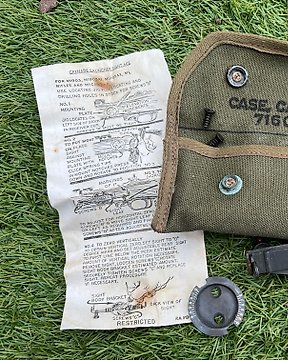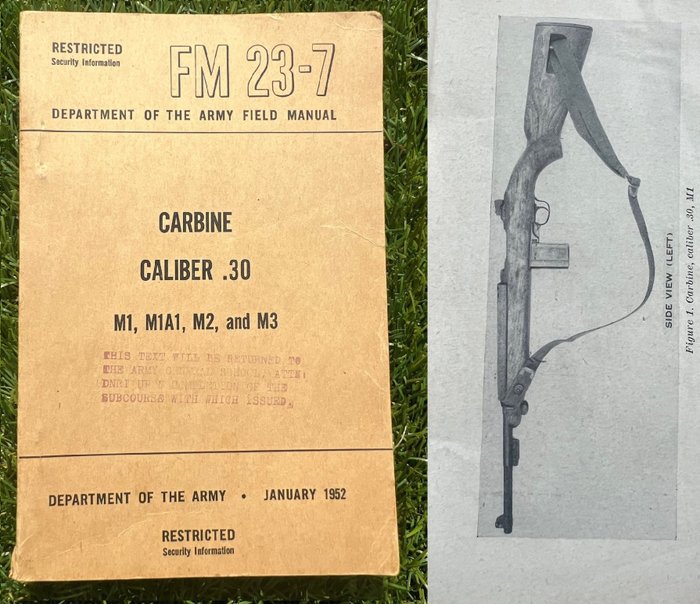
United States of America - WW2 USA M1 Carbine / M1 Garand Grenade Launcher Sight - Pouch / Instructions - Infantry - Airborne - Military equipment - 1944
No. 75082307

No. 75082307

Rare 1952 dated U.S.A official army manual related to SPECIFICALLY the infamous M1 Carbine. However, this basically covers all WW2 models, and therefore is a bible for the WW2 collector. NOT A REPRINT!, but the original 1952 edition. Over 350!!! pages of very interesting information and abundant photo's and plates; maintenance, use, ammunition, parts, drawings and many photo's. Great rare item and highly illustrative for your WW2 usa collection, you dont find this manual easily! The photo's outside in the sun makes the manual actually look more yelllowed than it is.
History of the M1 Carbine
The M1 carbine with its reduced-power .30 cartridge was not originally intended to serve as a primary weapon for combat infantrymen, nor was it comparable to more powerful assault rifles developed late in the war. However, it was markedly superior to the .45 caliber submachineguns in use at the time in both accuracy and penetration,[10] and its lighter .30 caliber cartridge allowed soldiers to carry more ammunition. As a result, the carbine was soon widely issued to infantry officers, American paratroopers, non-commissioned officers, ammunition bearers, forward artillery observers, and other frontline troops.[35] The first M1 carbines were delivered in mid-1942, with initial priority given to troops in the European Theater of Operations (ETO).[10]
During World War II a standard U.S. Army infantry company was issued a total of 28 M1 carbines.[36] The company headquarters was issued nine carbines (for the company commander, executive officer, first sergeant, mess sergeant, supply sergeant, bugler, and three messengers), the weapons platoon was issued sixteen carbines (for the platoon leader, platoon sergeant, two platoon messengers in the platoon headquarters, one messenger in each of the two mortar and machine gun section headquarters, and ten for the mortar and machine gun ammunition bearers), and the three rifle platoons were issued one each (for the platoon commander).[36]
The M1 carbine gained generally high praise for its small size, light weight and firepower, especially by those troops who were unable to use a full-size rifle as their primary weapon.[21][37] However, its reputation in front-line combat was mixed and negative reports began to surface with airborne operations in Sicily in 1943,[38] and increased during the fall and winter of 1944.[39]
In the Asiatic-Pacific Theater, soldiers and guerrilla forces operating in heavy jungle with only occasional enemy contact praised the carbine for its small size, light weight, and firepower.[40] However, soldiers and Marines engaged in frequent daily firefights (particularly those serving in the Philippines) found the weapon to have insufficient penetration and stopping power.[20][41] While carbine bullets would easily penetrate the front and back of steel helmets, as well as the body armor used by Japanese forces of the era[42][43] reports of the carbine's failure to stop enemy soldiers, sometimes after multiple hits, appeared in individual after-action reports, postwar evaluations, and service histories of both the U.S. Army and the U.S. Marine Corps.[20][41]
The carbine's exclusive use of non-corrosive-primer ammunition was found to be ideal by troops and ordnance personnel serving in the Pacific, where barrel corrosion was a significant issue with the corrosive primers used in .30-06 caliber weapons.[20] However, in the European theatre, some soldiers reported misfires attributed to moisture ingress of the non-corrosive primer compound.
How to buy on Catawiki
1. Discover something special
2. Place the top bid
3. Make a secure payment